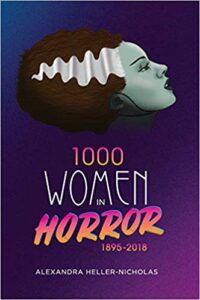1000 Women in Horror, 1895-2018 by Alexandra Heller-Nicholas
BearManor Media, 2020
ISBN-13: 9781629333861
Available: Hardcover, paperback ( Bookshop.org )
1000 Women in Horror, 1895-2018 is a beautiful book that includes the stars and women behind the scenes who have molded the horror genre. Heller-Nicholas provides a global view of the “vast number of women who have worked in the creation of dark and spooky movies for well over a century, both behind and in front of the camera, and in films both widely known and comparatively obscure.” The author includes an incomplete, as she mentions, but still impressive filmography of full-length movies directed or co-directed by women in an appendix. Also included interspersed throughout book are interviews with Rutanya Alda, Tara Anaïse, Tonjia Atomic, Anna Biller, Axelle Carolyn, Aislinn Clarke, BJ Colangelo, Mattie Do, Julia Ducournau, Jordan Hall, Catherine Hardwicke, Katherine Kean, Karen Lam, Izzy Lee, Barbara Magnolfi, Marsha Mason, Donna McRae, Patrushkha Mierzwa, Hannah Neurotica, Alexandra Paul, Isabel Peppard, Cassandra Peterson, Debbie Rochon, Mia’Kate Russell, Gigi Saul Guerrero, Elizabeth Shepherd, Jen and Sylvia Soska, Brinke Stevens, Barbie Wilde and Silvana Zancolò.
Since this is more of a reference book with entries in alphabetical order, readers may not want to read it from cover to cover of course. However, having done so myself, it is wonderful to see how many women, and by no means a complete list of them, have had a direct hand in horror films. I found it particularly interesting that Heller-Nicholas chose to include those in front of the camera. As she points out in her introduction, acting “is a job” and often requires hard work, dedication, and time. With WiHM, we so often focus on the filmmakers that the actors themselves tend to go unnoticed in their efforts.
Alexandra Heller-Nicholas, a film critic from Melbourne, Australia, holds a PhD in Screen Studies from the University of Melbourne and is an Adjunct Professor at Deakin University and a Research Fellow at RMIT University. She has written eight books on cult, horror and exploitation cinema with an emphasis on gender politics. Given the quality of the research and care that went into 1000 Women in Horror, 1895-2018, I will definitely be checking out her other work. I do hope that at some point in the future there will be a Kindle edition released for accessibility.
Highly recommended
Reviewed by Lizzy Walker
Editor’s note: 1000 Women in Horror, 1895-2018 is a nominee on the final ballot for the 2020 Bram Stoker Award for Superior Achievement in Nonfiction.





Follow Us!